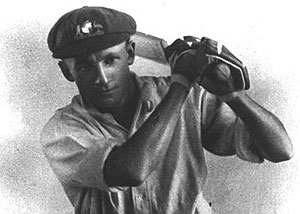Roar Guru

As far as I know, and I’m willing to be corrected on this point, the great man never played the game. But there is a connection, at least for me, occasioned by an article by Charles McGrath in a recent issue of the New York Times.
McGrath was writing about the Don Bradman of baseball, Ted Williams.
For those who may not know, Williams was the last player in the major leagues to bat over .400 in a single season (1941), and this accomplishment echoes – I’m not going to say parallels – Bradman’s amazing feat of averaging 99.94 runs in test cricket.
In his article, McGrath talks about the fact that one of the great novelists of our time, John Updike, wrote an essay about Ted Williams which remains a classic piece of sports writing.
Curiously, Updike never wrote about baseball again, but just that one effort set the bar for everybody else who did.
Reading Updike’s essay, it’s easy to see similarities between the great batter and the great batsman. For a start, Williams had exceptional eyesight, and Bradman, too, had great eyesight, at least in his ability to pick up flight and spin earlier than most.
And their personalities were close: both men disliked the adulation accorded them and tended to be a little aloof. Both played in their later years hobbled by poor health. Williams was 42 when he played his last game, and Bradman 40 when he appeared in his last Test.
But there were big differences: Williams was tall with a good set of shoulders on him, while the Don was short and slight. Williams batted left-handed and threw from the outfield right handed while DB was strictly a righty with bat or ball.
Ted could slug line drives into the stands while Don was not famous for his sixes.
But if Williams had his Updike, Bradman did not have a scribe of similar repute to write about him, although Aussie Roland Perry was one novelist who weighed in with a well-received bio.
And although England had a fine tradition of classy sports writers – music critic Neville Cardus for one – it’s doubtful than any essay written about Bradman could equal the lyricism of Updike’s work re. Williams.
Updike compares Williams to Achilles, to a Calder mobile, to Donatello’s David standing on third base as though the bag were the head of Goliath. You can easily substitute Willams’ name for Bradman’s in the following: “Willaims is the classic player on a hot summer’s day, before a small weekday crowd, when the only thing at stake is the tissue-thin difference between a thing done well and a thing done ill.”
Updike identified with the artist in Williams (read Bradman): his focus and perfectionism, his single-mindedness in mastering the difficult craft of successfully wielding a bat.
“No other player visible to my generation,” Updike wrote, “has concentrated within himself so much of the sport’s poignance, has so assiduously refined his natural skills, has so constantly brought to the plate (crease) that intensity of competence that crowds the throat with joy.”
Updike’s comment, when he heard that Williams had finally hung up his spikes, was this: “He met the little death that awaits all athletes.”
The little death.
How apt is that?
No more to be the brilliant centrepiece while thousands cheer, an athlete quits and retires to the gray solitude of Valhalla.
As Updike explains re: all our sports idols, what holds our interest is not occasional heroics, but “players who always care; who care, that is to say, about themselves and their art.”
Don Bradman 1908-2001
Ted Williams 1918-2002
John Updike 1932 – 2009